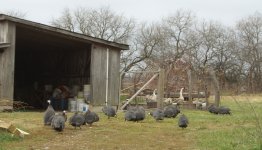As has been said earlier, the best and non-toxic way to get rid of ticks is free range guinea fowl. I always have 5 -10 guinea fowl on my farm. I also have free range chickens. Chickens eat ticks, too, but guinea fowl are the best. Between them, I have no ticks on any of my animals, dogs, cats, goats, sheep, horses or llamas.
I also don't use frontline on my dogs. It's a systemic pesticide that goes in their bloodstream. And I don't want pesticides on my farm. Don't need any of that with guinea fowl.
Ya know, I have heard that, about guinea fowl many many times, but have not tried them. I have also heard that ticks are a large part of the diet of wild turkeys. I do not know how well guinea fowl would survive up in this cold place that is the Siberia of the continental U.S., but I am going to recommend to my dad to get them for the 40 acres in Illinois. It might be the extreme cold, or the isolation of the plains, but so far as I know (knock on wood) we do not have the black-legged tick up here in ND yet that carries lyme Disease. Rocky Mtn. Spotted Fever - yes.
Ticks REALLY like, moist green, tall vegetation. They can survive I think months without a blood meal, but need moisture. They are blind and climb up on a piece of grass or brush and extend their greedy little legs and can sense carbon monixide from your breath, like a mosquito can. They need the blood to re-produce. The "seed ticks" are just immature regular ticks. Up here, they are out in droves in late spring and early summer, and then seem to slack off, except in the tall grass where it is moist, during mid to late summer when the mosquito population thrives.
Here is a tick eradication web site:
Tick Control & Management
My tick control "plan":
1. Continue to keep the area near the house and along the road mowed frequently to 1.5" high (7 hours a week during mowing season).
2. Eliminate "mouse" habitat near the residence and farmstead like old wood piles, logs where I frequently find them, etc. They are the primary spreader of ticks, along with the deer poplulation. The cats control a lot of them too. Hantavirus is a concern with mice, as well.
3. In early spring, burn off the tall grass near the residence, along the fence lines, between the road and the plowed fields. (in a controlled fashion from wide fire breaks)
4. Conduct understory burns in the oak stands every few years (the effects are temporary for a few months). This also controls understory brush where the ticks sit and wait.
5. Look into guineau fowl (if the racoons, skunks and coyotes do not get them)
6. Continue to encourage prescribed grazing (not over-grazing) of the pasture and mowed trails to control dense tall grass where the ticks like to hide.
7. Keep the trails brushed and sprayed to keep down over-hanging brush and weedy growth. (Remedy Ultra 1/4%, Forefront HL 1/2% Surfactant or MSO 1/2% with spray wand and 2 nozzle 25 GL Fimco sprayer)
8. During tick season, apply Permanone to clothes and let dry and stay out of the tall grass. (Not sure on any long term effects, so I don't apply this unless I have to)
9. As a LAST RESORT, spray the yard, trails with arachnicides listed in the above web site. This would be done if Rocky Mountain Spotted Fever, Lyme disease or West Nile Virus from mosquitos occurs here and becomes more of a threat than any carcinogenic (cancer-causing) effect from chemical application. This diatomaceous earth is worth looking into and I will contact some entemologists at some universities and some extension agents to check into this. Bacillus thuringensis is a naturally occurring agent, but I do not think that it controls ticks. Even though Pyrethrin comes naturally from a flower, it is a nerve agent.
SC

